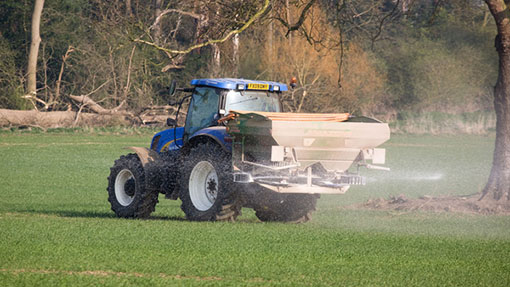Potash needed for better nitrogen efficiency

Record January rainfall and neglect of potash levels could jeopardise the efficiency of nitrogen applications this spring, say experts.
Jerry McHoul of fertiliser supplier K+S UK & Eire says that if nitrogen is the fuel and phosphorus the key in the ignition, potash definitely represents the oil in the engine.
“Not only does potash keep nutrients, sugars and fluids pumping around the plant, it also affords a protective role with positive effects on reducing lodging risk, disease susceptibility, drought and both high- and low-temperature stress,” he adds.
Mr McHoul warns that without sufficient potash, a plant cannot take up and hold onto adequate supplies of water or other nutrients, and will suffer both heat and drought stress, which will curtail yield and also crop quality.
“It has a particularly close relationship with nitrogen, because when taken up as a negatively charged nitrate form, a positively charged nutrient must match it and for most crops this is potassium.”
See also: Research questions benefits of urea additives
Studies at Rothamsted Research in Hertfordshire have shown that N use efficiency is 79% at K index 2, but just 49% in soils at K index 0.
This could mean that in crops on the UK’s most seriously K-depleted soils, only half of all applied N is utilised, representing a serious financial and environmental loss to growers.
Downward trend
Statistics from the British Survey of Fertiliser Practice 2012, just released by the Agricultural Industries Confederation (AIC) show that average potash use across arable and grassland stands at just 23kg/ha of K20.
That figure represents a drop on the previous year and a third lower than a decade ago. It is also estimated that 32% of arable soils and 43% of grassland are now deficient in potash.
Chris Tye, Frontier’s fertiliser manager says their analysis data, compiled by precision farming and nutrient mapping experts SOYL, confirms that the potash status in UK soils is far from ideal, with the number of those with soils in Indices 0 and 1 rising again in 2013.
“Coming at a time when nitrogen use is fairly static, this suggests that UK farmers are in danger of creating nutrient imbalances in their crops,” he says.
Mr Tye points out that nitrogen use efficiency can only be maintained if potassium in plants is at optimum levels and the ratios, based on current use, suggest otherwise.
“Growers should also be concerned about the potential loss of potash this winter,” he says.
“Where farmers have had nutrient holidays there’s no better reference point to start with than a detailed nutrient map. It is only through targeted fertiliser application, backed by soil analysis, that growers can raise indices and then maintain them at levels that support high crop productivity.”
Jerry McHoul, K+S UK & Eire
“While cereal and oilseed rape establishment has generally been strong and growth vigorous over the mild winter, plants will have taken up less than a sixth of their total demand, and this will rapidly increase with the onset of spring growth.
With the unprecedented winter rains and a record January rainfall figure potash is likely to have been redistributed deeper in the soil profile, particularly on lighter soils.
Target Index 2
Mr McHoul says that growers should be rebuilding the potash status of their soils and targeting index 2 as the standard for most arable crops and grassland, but going even further for high value crops such as vegetables and fruits.
He also points out that potash use also needs to be balanced alongside that of magnesium.
The Professional Agricultural Analysis Group (PAAG) surveys show that more than one-sixth of the UK arable area is Mg index 1.0 or less.
This could mean that large areas of oilseed rape and of cereals are also underperforming due to lack of magnesium.
“In our extensive six-year trial programme, applications of magnesium, on these low index sites, have increased mean oilseed rape yields by 0.21t/ha, so growers do need to check soil status for this macronutrient as well.
“Where farmers have had nutrient holidays there’s no better reference point to start with than a detailed nutrient map. It is only through targeted fertiliser application, backed by soil analysis, that growers can raise indices and then maintain them at levels that support high crop productivity,” he says.
Mr Tye points out that while potash prices have strengthened in recent weeks, they remain at low levels compared to where they have been in recent years.
For those growers that took a potash “holiday” when prices spiked, Mr Tye urges it is time to replenish the soil bank to ensure sustainable yields going forward.
“Six years ago it took around 6kg of grain to pay for a kg of potash but today it is closer to 3kg.
“While there are signs that some growers are realising the need to back better K use on their crops, and blenders are reporting strong order books through February, farmers who haven’t ordered already do need to move quickly to get supplies in good time,” explains Mr Tye.
He adds that the industry could struggle to satisfy orders, with delivery also likely to be difficult over a narrowing logistical period when demand for nitrogen is also at a peak.

